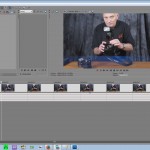Sony a7R preflash and shutter delay measurements
As a photographer, one of the worst things that you can do is to take a picture of someone who has their eyes closed. That is often caused by the preflash of your flashgun, which occurs right before the main flash. The camera is using preflash to test and calculate the amount of light that the flash needs to put out. When there is a long delay between the preflash and the actual flash used to take the photo, the subject will have time to close their eyes, which is a natural reaction to a flash(or preflash, in this case).
So the ideal situation is the shortest possible time between flash and preflash. Of course, you could eliminate the preflash entirely, by doing the flash calculation yourself, or by letting the flash itself do the calculation, in manual mode, but that’s another post for another time. For now, we are looking at how long the Sony a7R takes between preflash and flash.
All cameras will have some kind of delay between the time that the button is pressed to take the picture, and when the picture actually gets shot, without using a flash. So how much no-flash delay does the a7R have, and how much time does the flash add to that delay? Imaging Resource has this to say about the no-flash delay: “When manually focused, the Sony A7R’s lag time only dropped to 0.261 second, which is a bit on the slow side for manual focus shutter lag. The Sony A7R’s prefocused shutter lag time was 0.163 second which while quick, is much slower than most DSLRs or CSCs.” http://www.imaging-resource.com/camera-reviews/sony/a7r/sony-a7rA6.HTM
To give you an idea of how slow that is, they measured the mirrorless Sony NEX-5N prefocused time to capture at 0.022 second(no flash involved). The a7R, with it’s mechanical shutter, is considerably slower, which is going to really increase the preflash to flash delay.
Measuring that delay can be done at home, by shooting video of the camera taking a picture, that uses the flash. It won’t be totally accurate, but you’ll get an approximate number. We already have video of that online, thanks to David Kilpatrick, over at http://www.photoclubalpha.com: http://www.youtube.com/watch?v=yX9oXHnJZEs
In the screen capture below, you can see individual frames from the video, that barely shows just when the preflash started, and much more obviously, when the actual flash happened, five frames later. There are five clean frames in between those events, and at 25 frames per second, it’s 5/25th of a second delay(two-tenths of a second). David shot several flash events in that tape, and the rest of them all had four clean frames between preflash/flash, which is 4/25th of a second, or .16 second delay. Compare that with the .163 second shutter delay that Imaging Resource measured, and you can see that the flash doesn’t add too much to the overall time-to-capture delay. The worst case scenario for preflash/flash delay appears to be almost 1/25th of a second. The mechanical shutter is actually what’s causing most of the delay.
Dan Euritt



